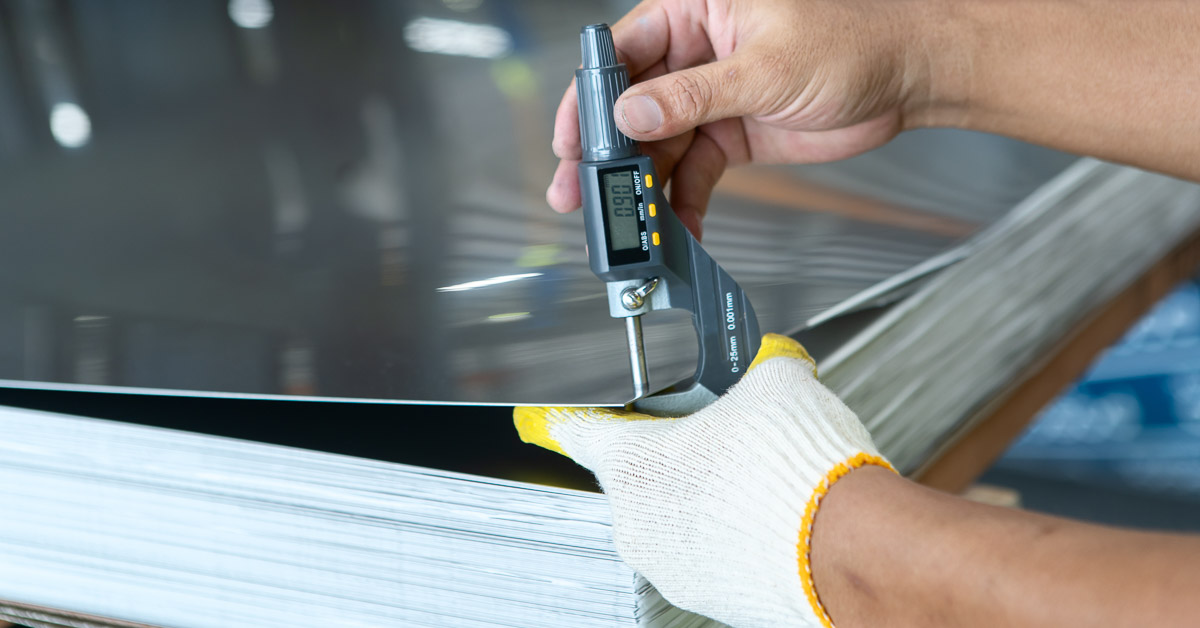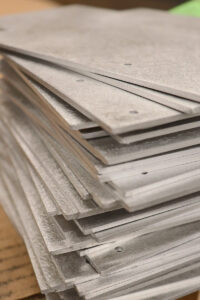
Understanding sheet metal thickness is fundamental to strength, bend behavior, and cost. Because gauge values vary by material, a single number can mean different dimensions in steel, stainless, aluminum, or copper—which is why we built this no-nonsense conversion guide. Drawing on decades of fabrication at PEKO, you’ll find accurate inch-to-mm charts plus practical tips to choose the right thickness for your part, process, and tolerances.
Quick Takeaways
- Lower gauge = thicker sheet.
- Gauge standards vary by material (don’t mix steel with aluminum charts).
- For tight tolerances, measure actual thickness with a caliper or micrometer before fab.
- Match thickness to function, environment, process, and tolerance needs.
What is Sheet Metal Thickness vs. Gauge
- Thickness is the actual measured value (inches or millimeters).
- Gauge is a standardized number that corresponds to a nominal thickness, and that number changes by material There’s no single universal formula—use the right chart below.
Pro tip: For RFQs, list both the gauge and the thickness (e.g., “16 ga steel (0.0598 in / 1.519 mm)”) to eliminate ambiguity.
Sheet Metal Gauge Conversion Charts
Below are the standard gauge-to-thickness conversions used in the U.S. for steel, galvanized steel, stainless steel, aluminum, and copper. Actual sheet metal thickness can vary slightly mill/source and coatings. For precision parts, verify material with a micrometer before programming, bending, or welding.
Steel Sheet (U.S. Standard Gauge)
| Gauge | Inches | mm |
|---|---|---|
| 10 | 0.1345 | 3.416 |
| 12 | 0.1046 | 2.659 |
| 14 | 0.0747 | 1.897 |
| 16 | 0.0598 | 1.519 |
| 18 | 0.0478 | 1.214 |
| 20 | 0.0359 | 0.912 |
| 22 | 0.0299 | 0.759 |
| 24 | 0.0239 | 0.607 |
Galvanized Steel Sheet (U.S. Standard Gauge)
| Gauge | Inches | mm |
|---|---|---|
| 10 | 0.1382 | 3.510 |
| 12 | 0.1084 | 2.753 |
| 14 | 0.0785 | 1.994 |
| 16 | 0.0635 | 1.613 |
| 18 | 0.0516 | 1.311 |
| 20 | 0.0396 | 1.006 |
| 22 | 0.0336 | 0.853 |
| 24 | 0.0276 | 0.701 |
Stainless Steel Sheet (U.S. Standard Gauge)
| Gauge | Inches | mm |
|---|---|---|
| 10 | 0.1406 | 3.571 |
| 12 | 0.1094 | 2.779 |
| 14 | 0.0781 | 1.984 |
| 16 | 0.0625 | 1.588 |
| 18 | 0.0500 | 1.270 |
| 20 | 0.0375 | 0.952 |
| 22 | 0.0313 | 0.794 |
| 24 | 0.0250 | 0.635 |
Aluminum Sheet (U.S. Standard Gauge)
| Gauge | Inches | mm |
|---|---|---|
| 10 | 0.1019 | 2.588 |
| 12 | 0.0808 | 2.052 |
| 14 | 0.0641 | 1.628 |
| 16 | 0.0508 | 1.290 |
| 18 | 0.0403 | 1.024 |
| 20 | 0.0320 | 0.813 |
| 22 | 0.0253 | 0.643 |
| 24 | 0.0201 | 0.511 |
Copper Sheet (U.S. Standard Gauge)
| Gauge | Inches | mm |
|---|---|---|
| 10 | 0.1340 | 3.404 |
| 12 | 0.1040 | 2.642 |
| 14 | 0.0795 | 2.019 |
| 16 | 0.0640 | 1.626 |
| 18 | 0.0510 | 1.295 |
| 20 | 0.0400 | 1.016 |
| 22 | 0.0316 | 0.803 |
| 24 | 0.0253 | 0.643 |
Why Sheet Metal Thickness Matters
Selecting the correct gauge is critical because it directly affects:
- Structural Strength: Lower gauges (thicker) increase rigidity and load capacity.
- Formability: Thinner sheets bend with less force and reduce tool
- Weight: Critical for aerospace, transportation, and handheld products.
- Weldability & Joining: Thin sheet needs controlled heat to avoid burn-through; thick sheet needs more energy and penetration.
Choosing the Right Sheet Metal Thickness
Use this fast framework before you commit to a material callout:

- Define the Function –Is the part structural, cosmetic, or protective? Structural brackets often start at 12–16 ga steel; cosmetic covers can be 18–22 ga.
- Assess Environment – Moisture / chemicals / temperature push you toward stainless or coated / painted steel at equal gauge, or a different thickness to hit stiffness and corrosion goals.
- Plan the Process – Cutting method (laser/plasma/shear), minimum pierce size, and inside bend radius affect feasibility. Tight bends in thicker gauges may require reliefs or larger radii.
- Set Tolerances & Flatness – For tight GD&T, confirm nominal vs. actual thickness. Thickness deviations change bend allowance, K-factor, and final dimensions.
Tip from the shop floor: Always match gauge choice with your forming and fastening methods (self-clinching hardware, hemmed edges, PEM® nuts, etc.) to avoid costly redesigns later.
Keep Your Project on Spec
Whether it’s a one-off qualification build or a full production run, PEKO ensures every sheet meets your spec—thickness, finish, and performance—with vertically integrated cutting, forming, welding, painting, and assembly.
→ Request a quote or talk with an engineer today








